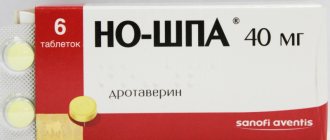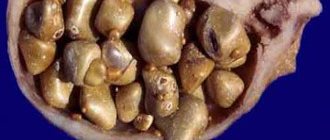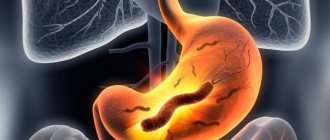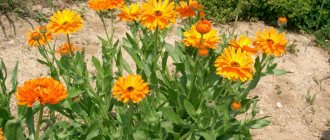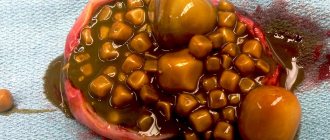What is suspension in the gallbladder?
In the modern world, one third of the population suffers from gallstone disease.
Thanks to scientific advances, surgery and pharmacology, the percentage of life-threatening complications is steadily decreasing. At the same time, the possibilities of non-invasive diagnostics are expanding. Timely examination of the organs of the biliary system allows you to avoid early operations.
The decisive diagnostic technique is ultrasound examination of the abdominal organs (ultrasound). The high resolution of this method makes it possible to detect deviations from the norm at the earliest stages. The first pathological signs that can be detected on ultrasound are suspensions in the gallbladder. Normally, there should be no suspensions.
Echogenic suspension in the gallbladder
In the first stages of stagnation in the biliary system, ultrasound scanning reveals an echogenic suspension in the gallbladder. Losing its natural homogeneity, it becomes “flaky”, heterogeneous, and as a result of this, its acoustic resistance changes and flakes appear in the gallbladder.
If normally homogeneous contents absorb the ultrasonic signal, then when “sediment” or “flakes” appear, the ultrasonic wave is reflected, or so-called “echogenicity” appears.
Hyperechoic suspension in the gallbladder
Subsequently, when the components of the sediment stick together in the gallbladder, biliary sludge clots appear. The contents become denser and less homogeneous, and on ultrasound it is visualized as a hyperechoic suspension in the gallbladder.
Biliary sludge in the gallbladder
In a healthy person, the organ is filled with viscous, concentrated bile, homogeneous in its physical properties. At the initial stages of gallstone disease, stagnation of bile occurs, resulting in the formation of a sediment or suspension consisting of bile components - crystals of bile pigments, cholesterol and calcium salts. This condition is called biliary sludge, from biliaris (Latin) - “gall bladder” and sludge (English) - “mud”, which, in fact, is the initial manifestation of gallstone disease.
The sediment in the gallbladder is called biliary sludge
Losing its homogeneous physical structure, pathologically altered bile acquires new properties. The denser its components become, the more intense the return signal from the ultrasound scanner will be. Based on the nature of changes in biliary sludge during ultrasound examination, three groups are distinguished.
Fine suspension
When the adhesion of particles of bile sediment (biliary sludge) becomes intense, a fine suspension in the gallbladder is formed in the lumen. What is this? This is a sediment that consists of microlites - small - up to 4-5 mm hyperechoic inclusions without an acoustic shadow, which can be clearly visualized when the patient’s body position changes during the study.
Sludge
During sludge, the contents of the organ that deposits bile can be densely filled with clots of putty-like, “silty” consistency, the so-called. sludged bile. Scanning of these changes also reveals a hyperechoic suspension, with a horizontal level without acoustic shadow, slowly changing in accordance with changes in the patient's body position.
Sludge bile
When the components of sludged bile crystallize, it is possible to observe a combination of fine suspension - microlites with thick sludged bile. Gallbladder sludge syndrome is the onset of gallstone disease.
Types and composition of suspended matter
The suspension varies in origin, consistency, and chemical composition. The heterogeneous contents of the gallbladder are classified according to the degree of echogenicity determined during ultrasound examination.
From the point of view of chemical composition, a suspension can be formed:
- Cholesterol (this is one of the components of bile);
- Bile pigment;
- Calcium salts.
Based on consistency, the suspension is divided into sand, flakes and sludge. These inclusions, depending on the position of the human body and its condition (rest, physical activity), change their location in the organ, moving in the bubble (parietal suspension, etc.). Sand grains settle the fastest; slow movement is a characteristic feature of flocculent sediment and sludge.
Depending on the degree of echogenicity, the suspension can be:
- Echopositive;
- Hyperechoic;
- Biliary sludge.
The echo suspension on the ultrasound monitor screen is gray. The denser the contents, the lighter it is on ultrasound (with cholelithiasis, white stones are visible on the screen). The echo-positive suspension contains flakes and is formed at the onset of the disease. This type of sediment does not have much density.
The flakes can disintegrate and in this form exit through the bile ducts into the intestinal tract. The sediment is colored in dark gray shades.
A hyperechoic suspension indicates that the flakes are collected into jelly-like clots that are more voluminous and dense (they are lighter on ultrasound). These clumps are called sludge. Doctors also compare this consistency to putty.
The general name biliary sludge refers to all types of echo suspension, regardless of origin, size and consistency. Depending on the size, it can be:
- Fine;
- Coarse (6 mm or more).
Fine suspension does not produce an acoustic shadow. Biliary sludge may be the initial stage of stone formation in the gallbladder. Sludged bile is a mixture of various elements that are denser than pure bile.
Its appearance means the progression of congestion. The presence of such inclusions is a prerequisite for mandatory treatment to prevent cholelithiasis.
Sludge is a phenomenon that occurs only against the background of stagnation of bile.
Reasons for the formation of suspended matter
It has been noticed that suspension in the gallbladder is formed not only due to pathological, but also physiological factors, which can be divided into groups:
- Causes due to the presence of liver diseases and other related diseases:
- performing shock wave lithotripsy aimed at destroying biliary stones;
- pancreatic diseases;
- long-term use of certain groups of antibiotics (cephalosporins), cytostatics, calcium supplements;
- obstructive jaundice (obstruction of the bile duct);
- hydrocele of the gallbladder;
- diabetes;
- fatty liver;
- taking tablet contraceptives, etc.
- Nutritional factor:
- diets with limited carbohydrates and fats;
- excessive consumption of fatty fried foods, smoked foods, “fast food”;
- sudden weight loss or weight gain.
- Hereditary:
- abnormalities in the development of the hepatobiliary system, complicating the outflow of bile;
- sickle cell anemia, etc.
- Predisposing factors:
- female;
- pregnancy;
- elderly and senile age;
- menopause;
- physical inactivity, etc.
When a sediment occurs without an obvious and understandable reason, it is customary to speak of an idiopathic suspension, the symptoms of which we will consider below.
Diagnostics
Suspension in the cavity of the gallbladder at different stages of pathology is determined differently:
- The echogenic suspension is visualized in the form of flakes with a heterogeneous structure; the presence of an echogenic suspension indicates the initial stage of bile stagnation;
- Hyperechoic suspension is visualized as denser contents with less homogeneity, which is due to the gluing of sediment particles and the formation of bile clots;
- Biliary sludge is a directly formed sediment represented by bile pigments, lipid particles, and salts.
First of all, an anamnesis is collected: when the pain appeared, where it is localized, its nature and intensity, etc.
The doctor takes into account such data as taking medications, the presence of gastrointestinal diseases, liver diseases, and alcohol addiction. This is followed by an external examination and palpation.
It is imperative to take a urine, feces and blood test to identify background or concomitant pathologies and complications.
A biochemical blood test is prescribed to identify changes in liver enzymes, determine the concentration of bilirubin and total protein, cholesterol, and the rate of the metabolic process. A consultation with a therapist may be scheduled.
As for instrumental research options, the following are prescribed:
- Ultrasound of the abdominal organs. This is the main method for diagnosing sludge syndrome. It allows us to determine whether there is a hyperechoic or any other suspension in the gallbladder. During the diagnostic process, clots, flakes, their quantity, displacement are determined, and the condition of the bladder walls is also assessed;
- Computer and magnetic resonance imaging (CT and MRI) of the abdominal organs are used to detect pathological changes in the liver and bladder;
- Duodenal sounding. The procedure involves collecting bile from the duodenum and examining it microscopically.
Mechanism of sediment formation
In the mechanism of suspension formation, the main role is played by stagnation in the biliary system as a whole, as well as a violation in the system of the dynamic balance between factors that prevent the aggregation of bile components and factors that promote it.
Bile is a digestive juice produced by the liver. Coming from the liver to the gallbladder, to ensure reserve digestive function, it is concentrated many times, acquiring the properties of a viscous, viscous substance. With its slow outflow and increased cholesterol content, gluing and crystallization of bile pigments and cholesterol into microlites occurs and their subsequent increase.
What threatens the appearance of suspended matter?
If a suspension is found in the gallbladder, it is recommended to consult a specialist. If this is not done, this condition will have the following consequences:
- Deterioration of the outflow of bile, resulting in blockage of the bile ducts;
- Formation of gallstones;
- Movement of stones along the biliary tract with possible blockage of the ducts;
- Inflammatory process in the gallbladder with further development of cholecystitis.
To prevent this from happening, it is recommended that you take appropriate steps to correct the problem.
What are the symptoms of suspended matter?
Quite often, the presence of fine suspension does not manifest itself with any symptoms for a long time and biliary sludge is detected by chance during an ultrasound scan.
In other cases, there is a suspension in the gallbladder, its symptomatic manifestation is usually associated with the functioning of the digestive tract. Most often, the first symptoms will be painful discomfort and a feeling of “heaviness” in the projection of the right hypochondrium. Eating fatty foods and milk is usually a provoking factor.
Features of pain symptoms due to sediment in the gallbladder:
- the duration of pain in the gallbladder can vary from several minutes to several hours;
- character - from paroxysmal pain to constant, aching;
- the intensity of pain is rarely high.
Other symptoms of the presence of flakes in the gallbladder:
- nausea, sometimes vomiting;
- appetite decreases, sometimes until it is completely lost;
- bowel disorders that occur periodically can manifest as both constipation and diarrhea, sometimes alternating them (unstable stool).
Treatment
After analyzing the diagnostic results and making a diagnosis, the doctor prescribes treatment:
- With minimal disturbances, patients are prescribed a special diet close to table No. 5 and drug treatment aimed at eliminating the factors that caused the pathology.
- In more advanced cases, drugs are prescribed that eliminate bile stagnation, relieve pain and protect the liver. The patient also needs to follow a diet - the nutritious diet should not contain fried, fatty and spicy foods, eggs, flour products, sauces, including mayonnaise.
Treatment of the underlying disease may help clear the sediment in the gallbladder, as poor overall health is a risk factor for this condition.
If conservative therapy does not bring the expected results, then surgical treatment is indicated.
Surgery
People experiencing pain due to the presence of sediment in the gallbladder, or those who have developed stones, may require removal of the gallbladder - cholecystectomy.
There are two surgical methods: laparoscopic (less invasive, but has contraindications) and open cholecystectomy.
In both cases, general anesthesia is used, which means the person will be asleep.
Let us immediately note that people can function normally without a gallbladder.
Why is a polyp in the duodenum dangerous, what are its symptoms and treatment methods? You can read about this in a separate article on our resource. If you need to know what a lipoma is, go here. Here we talked about the causes of wen.
Non-surgical option
An alternative option is endoscopic retrograde cholangiopancreatography (ERCP). ERCP is not a surgical method.
The procedure algorithm is as follows:
- Administration of a sedative injection.
- Treatment of the pharynx with local anesthetics.
- An endoscope (a small flexible tube) is inserted through the mouth, esophagus and stomach into the ampulla, an opening in the small intestine. A small plastic catheter is passed through the endoscope. For visualization, a radiopaque contrast agent is injected through a catheter and images are taken using an X-ray machine.
- If a suspension or stones are detected in the bile ducts, endoscopic surgery is performed using special instruments.
This method also has a number of contraindications, so the choice of method is made by a doctor.
Just as before cholecysectomy, before ERCP, the patient must refrain from eating for several hours before the procedure. And then the doctor will give recommendations on dietary nutrition, which must be followed.
Read more about the first symptoms of gallbladder problems that cannot be ignored here:
Sediment in a child
Medicine has described cases of gallstone disease in children, starting from the first year of life, but such cases are extremely rare. Nevertheless, biliary sludge in children is a fairly common phenomenon in our time. The literature describes observations of visualization of sediment in a child in the first months of life using ultrasonography. There can be many reasons for this “rejuvenation” of the disease:
- child malnutrition, unbalanced feeding, weight loss;
- failure of liver enzyme systems, and, as a consequence, insufficient utilization of certain groups of medications, especially in young children;
- children after surgical interventions for organ and tissue transplantation - forced systemic intake of drugs that prevent the rejection of donor tissue disrupts the exchange of bile acids;
- congenital conditions that prevent adequate flow of bile;
- maternal diseases, the need for systemic use of medications during pregnancy and breastfeeding;
- stress factors that can cause prolonged spasms of smooth muscles, incl. bile ducts, relevant for teenage children;
- other factors found in the adult population.
Making a diagnosis in childhood is not difficult, provided a carefully collected medical history and timely examination of the child.
Causes
Based on medical observations, long-term stagnation of bile provokes the appearance of flakes and any other irregularities in it. The difficulty is that soon the stage of formation of heavier masses - stones, which are considered life-threatening diseases, will begin.
Untimely detection of any inclusions, in addition to stones, threatens the development of pancreatinitis, acute cholangitis, cholecystitis and a number of other associated abnormalities.
From the statistics it follows that compactions begin to appear in people regardless of social status or nationality.
However, there are a number of factors that contribute to the increase in the amount of suspended matter. They are divided into reversible, that is, those that are temporary, and irreversible, the influence of which is almost impossible to regulate.
Reversible factors:
- Food. Frequent use of mono-diets and long-term consumption of products containing genetically modified components increase the risk of irregularities in the gallbladder.
- Medicine. Previous operations, taking oral contraceptives, diabetes mellitus, pancreatin, and inflammatory processes in the gastrointestinal tract aggravate the course of the disease.
- Demography. Depending on the place of residence, one or another pattern of sediment diagnosis can be traced.
- Physiology. A sedentary lifestyle and pregnancy increase the likelihood of symptoms of sludge.
Irreversible factors:
- Physiology. Age and being a female provoke the development of the disease.
- Genetics. Genetic abnormalities in the functioning or structure of the digestive system, heredity in a special way influence the manifestation of the characteristics of sludge syndrome.
The use of medications contributes to the excessive accumulation of calcium and insoluble salts in the body, resulting in a decrease in metabolic processes in it, and this, in turn, leads to the appearance of flakes.
Pregnant women are most susceptible to the appearance of sediment, since their hormonal levels during this period are subject to changes, additional intake of vitamins and minerals increases the load on the gallbladder and, as a result, seals are formed in its contents.
Treatment of sludge (suspension, flakes) in the gallbladder
Treatment of gallbladder sludge can be started only after a thorough examination and only under the guidance of a doctor! An ultrasound is not always sufficient to make a diagnosis. Sometimes biliary sludge accompanies other diseases that we mentioned above. Then it may be necessary to carry out a full range of diagnostic measures.
So, for example, if a patient has a mechanical obstruction to the outflow of bile, the administration of choleretic agents may aggravate the problem, and, conversely, the administration of antispasmodics for an atonic state of the bile ducts will be ineffective.
Surgical treatment of biliary sludge is necessary only in cases where there are objective reasons for the impaired outflow of bile and/or there are organic lesions of the biliary system. In the vast majority of cases, a conservative approach to treatment prevails.
It should be remembered that regular balanced nutrition can achieve much more significant success than using medications. Here are some tips:
- You should eat regularly, if possible, 4 times a day.
- The diet should be balanced in proteins, fats, and carbohydrates.
- Preference should be given to vegetable fats, fiber, and fruits (especially citrus fruits).
- The viscosity of digestive juices is affected by the volume of liquid consumed during the day. The more liquid in the diet, the less viscous the bile will be. The volume of alcohol consumed per day should be at least 2 liters.
- Fatty, fried foods, smoked foods, mayonnaise, sauces, carbonated drinks, whole milk, black coffee, cocoa, and alcohol should be excluded from the diet.
If you have problems with stool, the diet for treating the gallbladder should be selected in such a way as to achieve regular daily bowel movements.
Drug treatment of sediment in the gallbladder is aimed, first of all, at ensuring adequate outflow of bile, synchronizing the work of the biliary system with the stomach, duodenum, and pancreas. Enzymes, antispasmodics, and ursodeoxycholic acid preparations are often added to treatment.
Diet for suspension in bile ducts
A prerequisite for successful treatment is diet. In the initial stages of the disease, it is enough to correct the diet to get rid of flakes and sediment. The fundamental principle of dietary nutrition in this case is to reduce the load on the biliary system. Fractional nutrition contributes to this: the daily diet is divided into small portions, which are taken at regular intervals. You need to eat at least four times a day. A nutritionist will tell you what to do and how to prepare dishes from permitted products.
Authorized products:
- lean meat (chicken, veal, rabbit);
- fresh vegetables and fruits;
- greenery;
- cereals;
- quality pasta.
The menu should consist of soups, cereals and casseroles from cereals and pasta, boiled pasta, boiled and baked meat. Steamed dishes are welcome. The daily diet should include fermented milk products, 50 g of butter and vegetable oil (in total), one chicken egg, rye and dried wheat bread or biscuits. When choosing berries and fruits, you need to exclude sour ones. Be sure to have a large amount of liquid - 2 liters of water, plus liquid in soups and drinks.
Prohibited:
- fat meat;
- animal fats;
- fried spicy food;
- pickles, preservation;
- confectionery and baked goods;
- onion, radish, horseradish;
- spices.
The ban applies to strong, rich meat broths: soups and other first courses are prepared with vegetable broth. Alcohol is strictly prohibited.
Important! Food should be warm: cold or too hot food, including drinks, lead to increased bile production.
Treatment with folk remedies
Problems of the digestive system are a case when treatment with folk remedies can be effective. It involves the use of medicinal herbs in the form of infusions, decoctions, teas, both anti-inflammatory and choleretic:
- chamomile decoction;
- infusions of corn silk, wormwood;
- tea from sea buckthorn, thyme, rose hips;
- berry fruit drinks.
Treatment with folk remedies is usually carried out over a 2-month course, once every six months.
How to remove sand and stones? Treatment methods
This pathology can be treated in the early stages using conservative methods (drug therapy (tablets and capsules) and treatment with folk remedies). In more advanced cases, when there are signs of acute or chronic calculous cholecystitis or there are large stones in the bladder that can block the bile duct, surgical intervention techniques are used.
If flakes are detected in a timely manner in the gallbladder, surgery is usually not required, and therapy is limited to medicinal methods of therapy. However, if the patient begins to be bothered by constant severe pain or a formed stone blocks the lumen of the bile duct, a cholecystectomy (surgery to remove the gallbladder) may be prescribed.
If the symptoms do not bother the patient much or their manifestation is periodic, then doctors recommend a set of measures, including following a special diet (“Treatment Table No. 5”), treatment with choleretic drugs and folk remedies. The pain syndrome is well relieved by various antispasmodic drugs (tablets “No-shpy”, “Mebeverine”, “Duspatolin” and so on).
In addition, you can use folk remedies as additional therapy. The use of traditional medicine recipes is not only an effective method of complementary therapy, but can also serve as an excellent preventative measure for this pathology.
Of course, there can be no talk of any self-medication (even with natural medicines). Only a specialist, based on medical history and results obtained using instrumental and laboratory diagnostic methods, has the right to prescribe the correct treatment, indicating the exact dosage and dosage regimen.
As a rule, folk recipes for the treatment of biliary sludge, which causes the formation of gallstones, are various infusions and decoctions based on medicinal plants or their preparations, which have an anti-inflammatory and choleretic effect on the body. A folk remedy involves a fairly long treatment, consisting of several long (from two to three months) courses of taking medications at certain intervals (most often, two courses per year).
There are a great many recipes that remove sand and small stones from the body, and it is simply impractical to list them all. Herbal treatment involves the use of herbs from which infusions and decoctions are prepared. Such collections may include rose hips, strawberry leaves, corn silk, beet juice, black radish juice, dill seeds, wormwood, St. John's wort, milk thistle, immortelle, yarrow and many, many other useful natural ingredients.
When taken on a regular course according to the regimen prescribed by the doctor, these medications can not only significantly reduce the amount of harmful suspended matter, but even help to completely get rid of its presence by being naturally removed from the bladder through the bile ducts.
Whatever conservative treatment method is used, a prerequisite for successful treatment is adherence to diet No. 5, otherwise the formation of gallstones will continue.
Its main principle is based on fractional nutrition, which implies frequent (five to seven times a day) intake of small (up to 300 grams) portions of food at regular intervals. Such a therapeutic diet requires giving up fatty, spicy, fried, smoked, pickled and pickled foods, as well as limiting the consumption of sweets, baked goods, sour fruits and berries and other foods that irritate the digestive system.
Read also: How to wear a bandage after gallbladder removal?
Alcohol and carbonated drinks should be completely avoided. It is recommended to consume lean meat (veal, chicken, rabbit and turkey), cottage cheese, fermented milk products, virgin vegetable oils, cereal porridges and soups in vegetable broth, as well as sweet fruits and berries, fresh and boiled vegetables and other dietary products.
Prognosis and prevention
If treatment is ineffective and the disease progresses, the following may develop:
- cholelithiasis;
- cholecystitis;
- cholangitis;
- acute biliary pancreatitis.
With timely diagnosis, a regular diet, proper nutrition, and the elimination of factors that impede the flow of bile, it is possible to achieve normalization of the function of the biliary system.
As preventive measures to prevent the development of biliary sludge, the following should be noted:
- Body weight control. You should focus on the optimal body mass index, taking into account age, and also avoid sudden weight loss and debilitating diets.
- Correction of the main pathological conditions that led to the formation of sludge in the gallbladder.
- Minimize the use of medications unless absolutely necessary (only as prescribed by a doctor).
Methods of treating the disease
Depending on the condition of the biliary tract, treatment can be carried out according to one of three schemes:
- For patients with minimal disorders, a corrective diet similar to table No. 5 is indicated, and drug therapy involves eliminating the causes that led to the development of the pathology.
- The second (main) group of patients is prescribed conservative treatment, which involves taking medications that eliminate bile stagnation, protect liver tissue and relieve pain. The patient is also prescribed a diet that excludes fatty, fried and spicy foods, flour products, eggs, mayonnaise and sauces.
- If such treatment is ineffective, surgery is prescribed.
A case from the practice of gastroenterologist Daniela Purgina, an expert on the website Pokhmelye.rf.
Flakes and suspension in the gallbladder are a fairly common occurrence. The most memorable case was that of a young girl who was diagnosed with a suspension in her gallbladder and recommended treatment, which she refused. At the same time, the girl adhered to a strict diet, which contributed to the loss of 20 kg in 6 months. The result of refusing treatment and such extreme weight loss was gallstones.
If echogenic impurities in the bile are not eliminated in a timely manner, the patient may develop biliary colic, pancreatitis, cholangitis or cholecystitis, and cholesterol pseudopolyps in the gallbladder. The condition of the gallbladder affects the entire body - read the article about why we need a gallbladder for details.
Secondary prevention involves normalizing body weight and eliminating diseases that contribute to the development of gallbladder pathology.
Suspension in the gallbladder can form gallstones over time. How to prevent this, as well as what to do if an attack of cholelithiasis does occur, read in a separate article.
An expert on the site Pokhmelye.rf, gastroenterologist Daniela Purgina, dispels a common misconception.
It is necessary to mention traditional medicine and alternative methods of treatment. They don't work, unfortunately. If there is a suspension in the gallbladder, ursodeoxycholic acid drugs, choleretic drugs, prokinetics, and antispasmodics are indicated. The scheme is selected individually: depending on the volume of suspension, complaints and other nuances.
